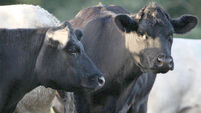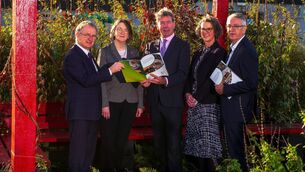Weather window draws business away from marts
Can’t be helped, it’s in the blood, and just for the record, in my time, I wasn’t much good, but I still like it.
I mention it because this week’s cattle trade is a lot like last Sunday’s Dublin-Meath match.
Despite being ten points down, Meath very nearly pulled themselves level at the end.
So too with the cattle business, despite recent set backs, the trade like Meath has rallied somewhat in the last seven days.
Favourites I’m told this year for the football however are Cork — so that’s where I’ll begin.
Tom McCarthy of Bandon mart tells me their sale on Monday was smaller than recently, which he attributed to farmers attempting to get silage cut and other jobs done.
“Men are very aware that time is running out as the year presses on and they need to get the work done” he said.
“Cattle sold away well, although the Friesians were under pressure” he commented. Under pressure too was the poorer quality cull cow, with some selling for less than a euro a kilo, while the better ones achieved upwards of €450 with the weight.
Although easier, Friesian bullocks still ranged from €240 to €580 with the weight, while the heifer trade saw prices coming in at between 320 and €740 over a euro per kilo.
Meanwhile, across the border in the county that considers itself the natural home of the Sam Maguire, Richard Hartnett of Castleisland was in good form following Kerry’s dispatching of Tyrone at the weekend.
He told me their show and sale on Monday was very big. “We had some extremely good weanlings. It’s just a pity the trade has eased a bit on previously” he said.
That said, the Italian shippers were paying upwards of €2.60 a kilo for bulls and €2.71 for heifers. “These being the top-end U pluses with even an occasional potential E thrown in,” Richard said. While they did that, the Irish men moved on the good range of top class Rs present.
“A good sale with great quality,” Richard concluded.
Moving back to Saturday last and the sale in Macroom, John O’Mahony said, “Friesians are back, maybe €100 to €120 a head in the last three weeks. Everything else though is holding well”.
The weather played a role, as in many places recently, with the improvement on Friday and Saturday seeing a lot of the Macroom men suspend mart plans in favour of much more pressing work to do with silage and hay.
“Attendance of men and beasts was less as a result,” John said.
“What’s becoming an issue is grass supply” he continued.
He explained that he has had conversations with farmers who are now beginning to see the longer lasting effects of the wet weather in fields that were poached.
This issue and others like it connected to ground conditions, grass supply and grass quality were common themes across the country, as farmers continue to struggle to get back on track this week.
Also on Saturday last, New Ross proved to be an exception to the trend in many yards where numbers have declined, coming in with “a big sale of 500” according to Richard Kirwan.
He explained that New Ross has moved to “double up” their weanling sale, usually held on a Monday, into their general cattle sale on Saturdays.
In relation to prices, Richard said, “they were back a bit, in fairness”.
Store cattle were “easier”, although “beef cattle held up reasonably well enough”, he said. Helped no doubt by the Northern men who now regularly attend, and who generally push on for the forward heifers and bullocks, he said.
In the weanling sale, moved to Saturday for the summer, prices eased somewhat, although the better continental types suitable for shipping did drive on well.
Also reporting a larger than expected sale was Marion Devane of Tuam, where 150 animals went under the hammer last Monday.
The weather situation last week in the Galway area appears to have been amongst the worst across the country. When I spoke to Marian on Tuesday, it had been raining more or less constantly since five o’clock on the previous day, Monday, with the forecast saying it might have eased by Wednesday.
The effect was to “drive cattle out”, she said. That said, prices were very solid judging by the figures I saw. On a lighter note, the talk around the office and canteen was that Donegal are a good bet for the football. Possibly, but I’m still hoping my €10 each way on Meath at 33/1 might deliver.
Meanwhile, down in Limerick, Kilmallock mart also took place on Monday, and saw numbers decline to just 544, as the local men took full advantage of the improvement in the weather and ground conditions to get some much needed farm work done. The fall off in numbers was such that demand saw prices bounce in some cases by between €50 and €80 euro, as the number of potential buyers outstripped supplies, according to Denis Kirby.
The combination of fine weather coupled with a lot of silage work done saw confidence return, Denis said.
Across in Nenagh on Tuesday, the story of smaller numbers was repeated, but this time, plainer cattle were “tougher sold” according to mart manager Michael Harty. That said, he commented that “no cattle went home unsold”. Asked whether the decision to sell made by some with plainer stock had to do with weather or grass considerations, Michael said the answer was possibly yes, but also there were bills to be paid.
“Meal and silage bills have to paid” he said.
Michael also gave consideration — as did a number of other mart managers — to the reality that with a lot of silage being only of middling quality, meal bills could very easily mount up this winter on both dairy and beef farms.
A reality that is going to take some very careful planning, should the winter be either hard or prolonged.
The previous Thursday had seen a smaller sale than recently in Kilkenny, with George Chandler reporting that numbers of both heifers and bullocks were back.
The trade, he considered, had “steadied” after the previous week’s price drop.
That said, George predicts, “If the weather becomes drier, both factories and marts will probably be looking for cattle”.
While the plainer types might have been more difficult, the quality animals were still capable of making €2.50 a kilo, with the tops pushing €2.80 a kilo.
My final stop this week saw me in conversation with Jimmy Walshe of Carlow Mart about their sale on Monday last.
Numbers were a “little slighter” he said.
Always a good man to assess the trade, he calculated that, “Prices are trending easier all across the board, with the heavier animal back possible €130 on three weeks ago, and the plainer ones €170”. He pointed out that the drop hadn’t happened all of a slap — but it had happened.
Like many other mart managers, he noticed that there are now less customers for the plainer type animal.
Part of the problem for men selling, he believes, is that cattle stopped thriving about a month ago, and now look a bit “drawn in on themselves”. He also reflected John O’Mahony of Macroom’s comments on the situation as regards the state of the grass supply and the lingering damage done to fields by stock during the very bad weather.
This he said was the main topic of discussion among farmers, more so than cattle prices after the sale.
The land, no more than the animals on it, has to be treated with respect.
Like a lot of others, I now find myself looking to get out of this year without seeing further damage done to my primary asset.













